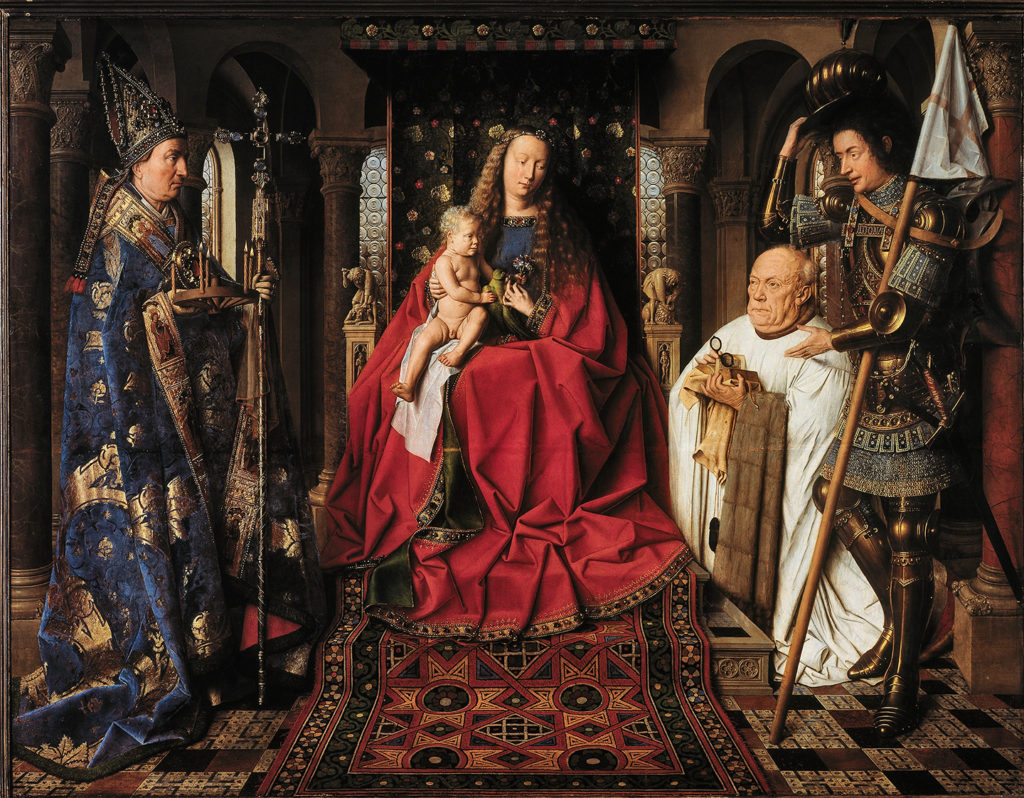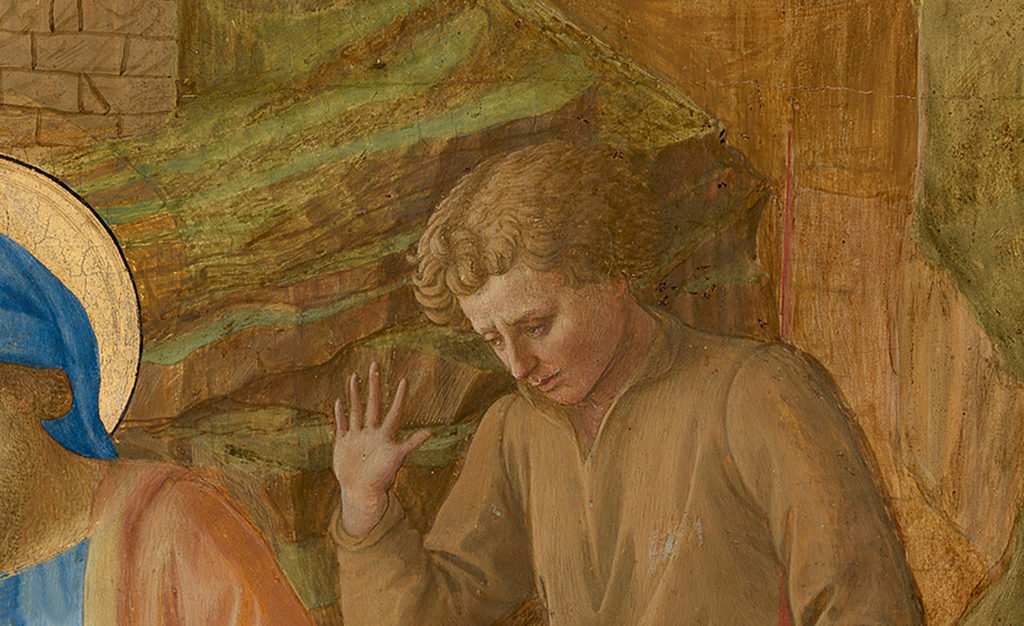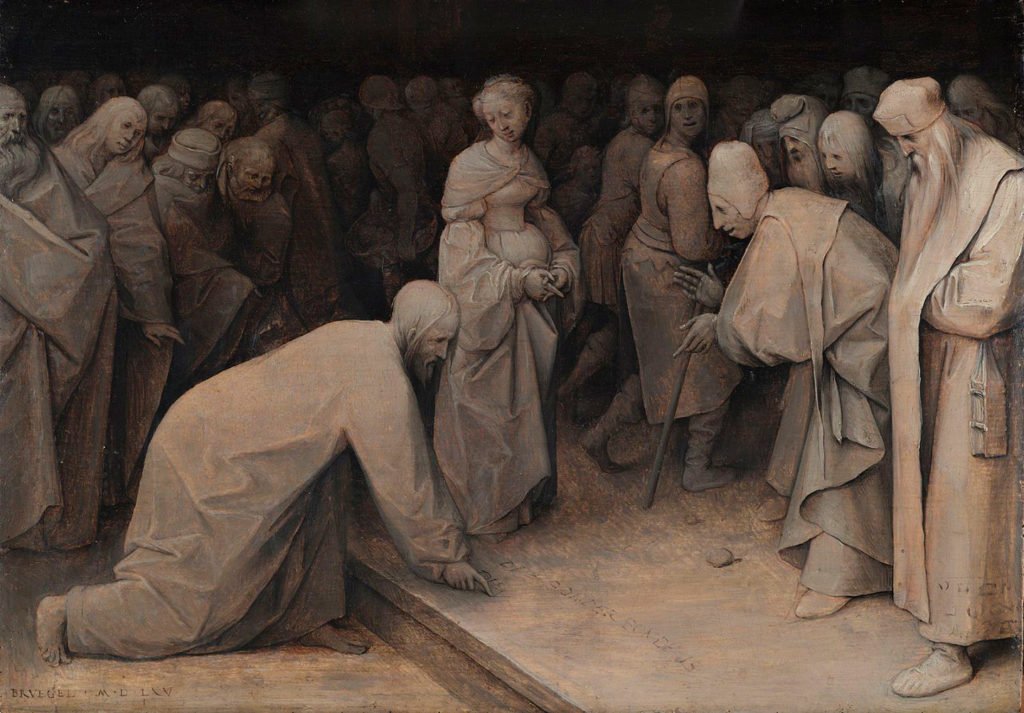Fra Angelico, The Annunciation, ca. 1440–1445, fresco, 5.5 ft. x 6.25 ft., Convent of San Marco, Florence, Italy. Fra Angelico dedicated his work exclusively to religious subjects as he understood art to be an aspect of religious devotion intended for contemplation and meditation. The artist’s masterpiece integrates the late Gothic Italian style with the new language of the Renaissance and recent discoveries of geometric perspective. Combining an architectural setting with landscape in the background, and fully formed human figures occupying the space added a narrative element and would forever change picture making.
Representational artists all share one common goal – to present an illusion of volume, accomplished in painting through the juxtaposition of dark and light values, and of highlights and shadows.
Although there are many variations on the execution, this illusion is accomplished traditionally through one of four basic techniques, each with historical significance and identifying characteristics, each with its own master artists, adherents and followers, and each predicting the evolution of its beneficiaries while guaranteeing a place in art history for its antecedents. But first, a bit of that art historical context.
No. 1: Basic technique – direct painting approach. In this most basic and very effective technique the artist, using a small brush and with carefully placed single strokes, applies light and dark valued color mixtures directly onto the surface of the panel that has already been prepared with a brownish-yellow imprimatura and umber underpainting. Dark values indicate shadows and light values indicate highlights. There is no blending of similar valued paint strokes into the surrounding pigments, and the surface reveals individual brush strokes that are clearly defined, retaining their original color mixtures. In addition, 14th and 15th century Italian painters were less interested in realistic optical effects (such as reflected light) as their goal was to achieve the idealized beauty of solitary colors and objects. Typically the medium used was pure egg tempera on panel; later egg and oil. It was the Italian artists that mastered the technique, and eventually organized into guilds that promoted a systematic and deliberate working method. Pure egg tempera panel paintings date from prior to 1400 – known as the ornate International Style – whereas those painted from 1400 to 1500 might be either pure egg tempera, or a combination of tempera and oil. The technique of painting in egg tempera was very demanding, and combined great skill and careful craftsmanship. The Italian artists and their guilds produced a masterful body of tempera paintings and a great many have survived to present day in good to excellent condition. Works by 14th and 15th century Southern European Italian painters including Cimabue, Giotto, Vivarini, Fra Filippo Lippi, Fra Angelico, Sassetta, Mantegna, Ghirlandaio, and Botticelli are examples of the technical and artistic virtuosity of the direct painting approach.
The 14th Century Renaissance color palette featured reds of realgar, carmine lake (cochineal), vermilion and madder lake, which were brought to Europe by crusaders in the 12th century, blues of smalt, azurite, ultramarine (lapis lazuli) and indigo. The greens were verdigris, green earth and malachite; the yellows were Naples yellow, smalt, ochre, orpiment, and lead-tin yellow. Renaissance browns were obtained from umber. Whites were lead white, gypsum and lime white, and blacks were carbon or bone black. Gold leaf was also employed not only in isolated areas like halos, embroidery and decorative elements, but often entire backgrounds, to evoke spiritual reflection, beauty and the emotional power of divine devotion.
Fra Angelico and Fra Filippo Lippi c. 1440 – 1460, The Adoration of the Magi. An ochre imprimatura and use of umber drawing and underpainting can clearly be seen In this detail from The Adoration of the Magi by Fra Angelico and Fra Filippo Lippi. The rocks, brick wall, and figure details have all been sketched in and loosely colored with an umber tone over which egg tempera body color has been painted. The verdaccio underpainting can be seen painted over the rocks with no additional overpainting, as well as the hand and face of the figure on the right, which has been been further modeled with reddish body color. Gold leaf has been applied to the halo on the figure on the left.
Fra Angelico likely used a technique that involved a brownish-red underpainting over a yellowish toned imprimatura made from yellow ochre and carbon black, over which he would then build up his final colors. This method helped establish the composition and value, creating a tonal foundation for the rest of the painting. In addition, figures were underpainted in a greenish gray known as verdaccio, using the traditional technique of mixing black, yellow ochre, white, and a bit of Venetian red, according to Cennino Cennini’s, (an Italian painter influenced by Giotto) “how to” manual on late Medieval and early Renaissance painting “Il libro dell’arte”.
These Italian artists broke the mold of their predecessor’s iconic, stiffly stylized, unreal and other-worldly figures and compositions by manipulating the effects of light and shade to communicate a sense of “reality” to the viewer. Sacred backgrounds were replaced with earthly settings mindful of symbolism and meaning. The Trecento artists used brushstrokes of light and shade to draw attention to the realness of the human form by emphasizing bodily curves, bulk and muscles. They painted real people with weight and form that were subordinate to the laws of gravity. Although the use of direct painting in tempera continued through the 15th century, by the beginning of the 16th century the materials and working methods of oil painting were sufficiently developed, understood and readily available. In the North however, things were brewing in the studios and ateliers, and within a very short time, egg or egg/oil tempera fell out of fashion and pure oil painting became the primary form of easel painting throughout Europe.

Jan van Eyck Virgin and Child with Canon Joris van der Paele, 1436. oil on oak panel, 4.625 ft. x 5.75 ft. Arguably the most elaborate and impressive demonstration of the artist’s fascination with optical concepts and effects, Van Eyck had a profound influence on European painting. This materpiece depicts Van der Paele, a wealthy canon of the Church of Saint Donatian in Bruges, kneeling before the enthroned Virgin and Child, flanked by Saint George and Saint Donatian. Van Eyck perfected a new technique of painting in oils that enabled him to achieve an unprecedented realism in rendering materials in glowing color. Groundbreaking achievements include the realistic figures, individualized portraits, play of reflections on the helmet and the brilliant differentiation between qualities of texture, as in the fabrics and brocades for example. A wealth of minute details are brought together in a convincing suggestion of spatial perspective.
No. 2: Transparent oil technique. Although the beginnings of oil painting are recorded as early as the 12th century in Northern Europe, it was the virtuoso handling of the medium by the Flemish and early Netherlandish masters that represented a major turning point in the adoption of oil painting as the dominant painting medium in Europe. With this more complex, systematic approach combining extraordinary realism with brilliant color, artists quickly discovered that the oil and pigment admixtures made most pigments translucent, allowing them to apply their colors in thin layers, or glazes, thereby generating the rich, glowing colors often associated with the portraits of Jan van Eyck and Rogier van der Weyden.
During the late 15th and early 16th centuries, many Northern artists traveled to Italy, creating paintings that, for the first time, combined regional traditions with elements borrowed from the Italian Renaissance, such as architectural forms and imagery from classical antiquity. In doing so, these artists created completely new, hybrid painting styles that helped spread Italian Renaissance culture throughout Northern Europe. Master painters such as the van Eyck brothers, Hans Memling, Pieter Bruegel Elder and Younger, Rogier van der Weyden, and Robert Campin developed and perfected the medium of oil painting, which was used to produce not only altarpieces and devotional works, but new categories of painting including landscape, animal, still life, and portraits. Their paintings are remarkable for their illusionism, astonishing and microscopic verisimilitude, attention to detail, and emphasis on materiality, that emphasized scenes and the experience of everyday life (genre painting) many of which were given a moralizing undertone.
These artists, like the group that preceded them, also perceived painting as a structured multi-layered construct that, from inception to completion, separated color and form. The artists were very knowledgeable in the optical properties of both light and color, and worked on a highly reflective white ground layer composed of chalk or marble dust mixed with glue, applied in many coats and burnished smooth between coats. The underpainting, quite different from those utilized by the 15th Century Italian tempera painters, resembled a white and gray, sometimes sepia, monotone version of the finished image with fully developed forms, painted in much the same way as the tempera artists that preceded them. This method of grisaille (In French “gris” means gray) painting became the standard technique of the time. Another technique utilized an underdrawing completed with fine brush strokes, some type of stylus, ink, or oil and black pigment. This was then covered with a thin transparent layer of umber-colored paint, or imprimatura, which allowed the drawing to show through thus establishing a mid-tone neutral color over the entire surface. White highlights were added as necessary, expediently creating a complete value range and a finished monochromatic underpainting. What is important to note here, regardless of the method used, is that the underpainting was an essential component of the structured approach.
Christ and the Woman Taken in Adultery by Pieter Bruegel the Elder, Netherlandish Renaissance printmaker and painter, signed and dated 1565. Once the underpainting was dry then the artists would employ a technique known as glazing, a very thin transparent layer of paint, to add color over a dry layer underneath. The light and dark modeling of the underpainting would show through the color, very similar to hand-coloring an antique black and white photo. Many layers would gradually be built up into the final painting. The painting shown here is a grisaille and art historians are unsure as to whether this painting is unfinished (never having color glazes applied) or was intended as a monochromatic work. Bruegel’s grisaille technique lends the scene the appearance of a sculpted relief, recognized by art historians as having an Italian influence.
Christ and the Woman Taken in Adultery by Pieter Bruegel the Younger, signed and dated 1628. Here can clearly be seen the effects of colored glazes apllied over a monochrome underpainting. Since The younger Bruegel is not known to have produced any grisaille works, the painting grants us a fascinating insight into the practices of the Brueghel family, and specifically into Pieter Brueghel the Younger’s artistic vision and interpretation of his father’s work. The artist has interpreted the scene in his own characteristically colorful palette, exposing more figures out of the darker background of his father’s work and carefully delineating them.
When dry, the painting was then completed by applying transparent glazes of color over the fully developed underpainting which defined the forms, the color remaining pure and luminous. The lightest lights were rendered with extremely thin applications of local color mixtures, with no visible brushstrokes. The underpainting whites were tinted appropriately with thinned oil and pigment. Since it was customary to leave no underpainting showing, darks had to be glazed rather thickly, using multiple layers of built up paint. This approach interestingly, foreshadowed the next technique, culminating in the dazzling technical virtuosity of two of greatest master painters of the 16th century.
More in Part 2.




2 Responses
You’re truly a wealth of knowledge, and the granular detail you know about the materials, process and context of these seventeenth century pieces never ceases to amaze me. I also greatly enjoyed the paintings that are newer to me (which were most)–looking at that Baccus and Ariadne, I can’t help but think I should rely much more on paintings than I have to teach mythology. So many of the literary regurgitations and summaries are just perfunctory works compared to vivid works of the imagination like this.
Thanks much for the generous comments Rory. -P